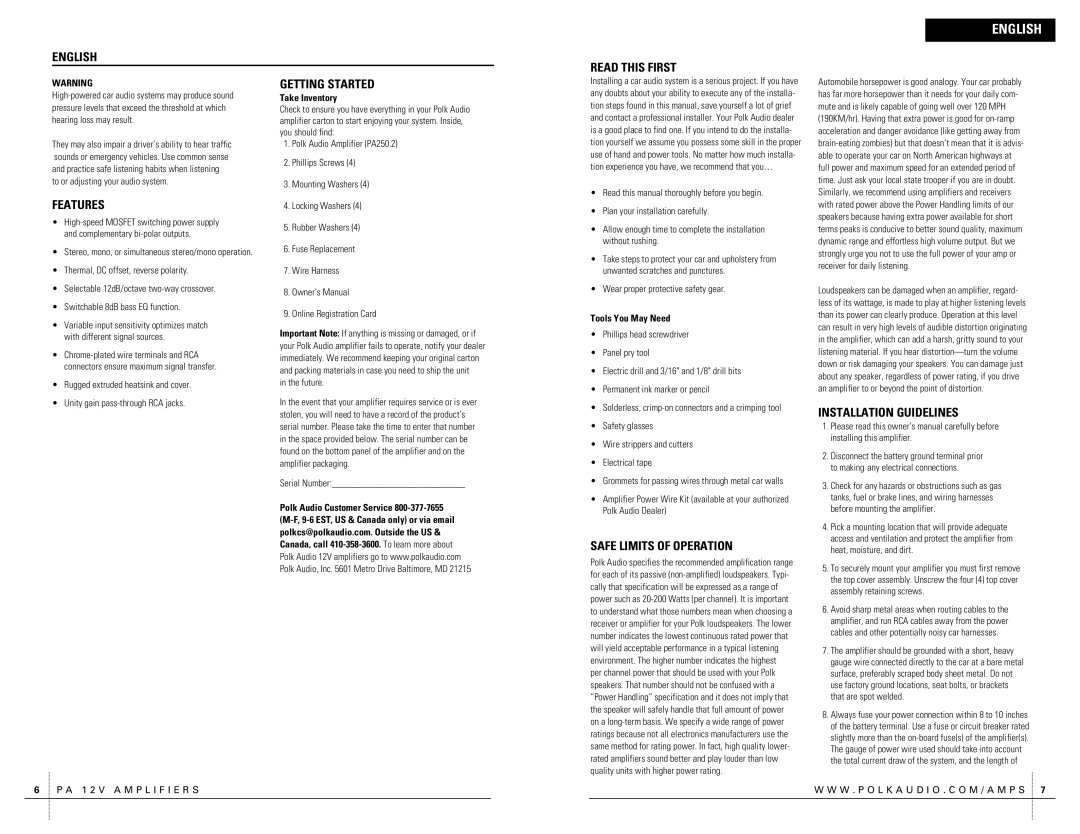
ENGLISH
ENGLISH
READ THIS FIRST
WARNING
They may also impair a driver’s ability to hear traffic sounds or emergency vehicles. Use common sense and practice safe listening habits when listening to or adjusting your audio system.
FEATURES
•
•Stereo, mono, or simultaneous stereo/mono operation.
•Thermal, DC offset, reverse polarity.
•Selectable 12dB/octave
•Switchable 8dB bass EQ function.
•Variable input sensitivity optimizes match with different signal sources.
•
•Rugged extruded heatsink and cover.
•Unity gain
GETTING STARTED
Take Inventory
Check to ensure you have everything in your Polk Audio amplifier carton to start enjoying your system. Inside, you should find:
1.Polk Audio Amplifier (PA250.2)
2.Phillips Screws (4)
3.Mounting Washers (4)
4.Locking Washers (4)
5.Rubber Washers (4)
6.Fuse Replacement
7.Wire Harness
8.Owner’s Manual
9.Online Registration Card
Important Note: If anything is missing or damaged, or if your Polk Audio amplifier fails to operate, notify your dealer immediately. We recommend keeping your original carton and packing materials in case you need to ship the unit
in the future.
In the event that your amplifier requires service or is ever stolen, you will need to have a record of the product’s serial number. Please take the time to enter that number in the space provided below. The serial number can be found on the bottom panel of the amplifier and on the amplifier packaging.
Serial Number:____________________________
Polk Audio Customer Service
Polk Audio 12V amplifiers go to www.polkaudio.com Polk Audio, Inc. 5601 Metro Drive Baltimore, MD 21215
Installing a car audio system is a serious project. If you have any doubts about your ability to execute any of the installa- tion steps found in this manual, save yourself a lot of grief and contact a professional installer. Your Polk Audio dealer is a good place to find one. If you intend to do the installa- tion yourself we assume you possess some skill in the proper use of hand and power tools. No matter how much installa- tion experience you have, we recommend that you…
•Read this manual thoroughly before you begin.
•Plan your installation carefully.
•Allow enough time to complete the installation without rushing.
•Take steps to protect your car and upholstery from unwanted scratches and punctures.
•Wear proper protective safety gear.
Tools You May Need
•Phillips head screwdriver
•Panel pry tool
•Electric drill and 3/16" and 1/8" drill bits
•Permanent ink marker or pencil
•Solderless,
•Safety glasses
•Wire strippers and cutters
•Electrical tape
•Grommets for passing wires through metal car walls
•Amplifier Power Wire Kit (available at your authorized Polk Audio Dealer)
SAFE LIMITS OF OPERATION
Polk Audio specifies the recommended amplification range for each of its passive
Automobile horsepower is good analogy. Your car probably has far more horsepower than it needs for your daily com- mute and is likely capable of going well over 120 MPH (190KM/hr). Having that extra power is good for
Loudspeakers can be damaged when an amplifier, regard- less of its wattage, is made to play at higher listening levels than its power can clearly produce. Operation at this level can result in very high levels of audible distortion originating in the amplifier, which can add a harsh, gritty sound to your listening material. If you hear
INSTALLATION GUIDELINES
1.Please read this owner’s manual carefully before installing this amplifier.
2.Disconnect the battery ground terminal prior to making any electrical connections.
3.Check for any hazards or obstructions such as gas tanks, fuel or brake lines, and wiring harnesses before mounting the amplifier.
4.Pick a mounting location that will provide adequate access and ventilation and protect the amplifier from heat, moisture, and dirt.
5.To securely mount your amplifier you must first remove the top cover assembly. Unscrew the four (4) top cover assembly retaining screws.
6.Avoid sharp metal areas when routing cables to the amplifier, and run RCA cables away from the power cables and other potentially noisy car harnesses.
7.The amplifier should be grounded with a short, heavy gauge wire connected directly to the car at a bare metal surface, preferably scraped body sheet metal. Do not use factory ground locations, seat bolts, or brackets that are spot welded.
8.Always fuse your power connection within 8 to 10 inches of the battery terminal. Use a fuse or circuit breaker rated slightly more than the
6 P A 1 2 V A M P L I F I E R S
W W W . P O L K A U D I O . C O M / A M P S 7
